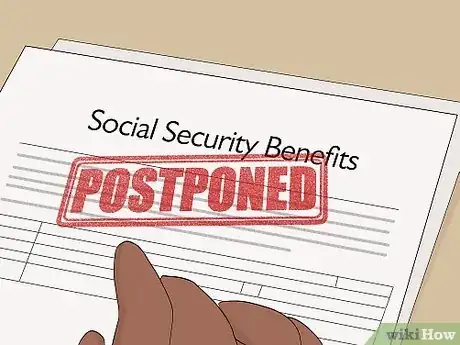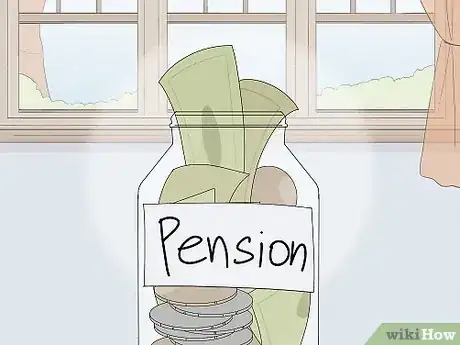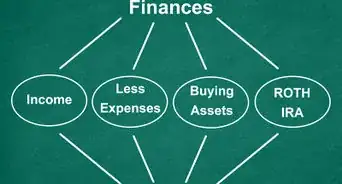This article was co-authored by Jonathan DeYoe, CPWA®, AIF®. Jonathan DeYoe is a Financial Advisor and the CEO of Mindful Money, a comprehensive financial planning and retirement income planning service based in Berkeley, California. With over 25 years of financial advising experience, Jonathan is a speaker and the best-selling author of "Mindful Money: Simple Practices for Reaching Your Financial Goals and Increasing Your Happiness Dividend." Jonathan holds a BA in Philosophy and Religious Studies from Montana State University-Bozeman. He studied Financial Analysis at the CFA Institute and earned his Certified Private Wealth Advisor (CPWA®) designation from The Investments & Wealth Institute. He also earned his Accredited Investment Fiduciary (AIF®) credential from Fi360. Jonathan has been featured in the New York Times, the Wall Street Journal, Money Tips, Mindful Magazine, and Business Insider among others.
This article has been viewed 13,496 times.
There are many good reasons you may be considering going back to work after retirement. Increased fulfillment, physical activity, additional income, and social engagement can all provide improved quality life, not to mention mental stimulation. You may also simply need to return to work for financial reasons. If you're a U.S. citizen, make sure to fully assess the financial impact that going back to work may have on your Social Security benefits, health care coverage, and other factors. In other countries, similar financial factors should also be considered before deciding to go back to work.[1]
Steps
Determining Effects on Social Security and Taxes
-
1Speak with a financial professional before returning to work. In the same way that it is important to get your finances squared-away before retiring, it is also extremely important to understand how returning to work will affect your finances. In particular, returning to work will likely affect Social Security benefits, taxes, health-care coverage and pension. If you do not know how returning to work will affect these important financial considerations, speak with someone who is familiar with your financial situation and who will be able to advise you regarding the impact of returning to work.[2]
-
2Assess your Social Security standing. Depending on your age and your income, your Social Security benefits will likely be reduced if you return to work. That said, you can still collect benefits and work, especially if you're only working part-time.[3]
- Most importantly, if you go back to work prior to full retirement age and earn a certain level of allowable income, your benefits will be reduced by $1 for every $2 you make above that level.
- Your full retirement age varies based on the year you were born, but is likely 66-70. As of 2016, the allowable income you can earn while receiving full Social Security benefits is $1,310 per month, or $15,720 per year.
Advertisement -
3Do the math. For example, if you go back to work in 2016 at age 64 while receiving benefits, and make $20,720 dollars over the course of the year (without reaching your full retirement age during that year), you made $5,000 more than the allowable amount while receiving benefits. This is the amount that will be ultimately used to determine the reduction in your benefits. The more you make, the more your monthly Social Security benefits will be reduced.[4]
- You'll need to report expected monthly income while receiving benefits. It is this number that will be used to determine the monthly reduction in your Social Security payment. If your income turns out to be different than reported, you will either owe additional taxes or be given a tax rebate after filing taxes.
-
4Postpone your Social Security benefits. Many people will benefit by postponing the point at which they begin to receive Social Security benefits. If you have retired, but have not begun receiving any Social Security benefits, consider waiting to do so until you've reached full retirement age (likely 66-70, depending on the year you were born). By doing so, you'll receive delayed retirement benefits that equate to greater financial gain in the long run.[5]
- If you retire, start receiving benefits, and decide to go back to work within a year, don't worry. You can stop the benefits dispersal, pay back what you were given, and maintain the ability to receive benefits when you retire for good.
-
5Acknowledge income tax considerations. If you're receiving money from investments, including distributions from a retirement plan, going back to work may put you in a higher income bracket and increase the taxes you owe. The main thing to consider is whether going back to work may actually cost you. In simplest terms, remember that your Social Security benefits will likely be taxed as federal income.[6]
- For instance, if you set up a 401(k) or IRA that deferred income tax until it was withdrawn from the account, the financial incentive for doing so was the assumption that you'd be in a lower income bracket after retirement. Essentially, you may wind up paying more (in taxes) to access the money in your retirement savings accounts.
- Outline a basic after-tax budget. Make an estimated bottom line assessment of how going back to work will ultimately affect your annual income.[7]
Accounting for Other Financial Considerations
-
1Take a job that offers health care benefits. If you have retired before being eligible for Medicare (at age 65), you may still be paying for healthcare. If you are paying for yourself and an spouse and are not covered through an employer, these costs could be substantial. Going back to work can be especially helpful in covering these costs, as you may have access to an employer based healthcare program.[8]
- You may even be able to work a part-time job that qualifies you for access to your employer's group health care plan.
- You will be penalized by an excise tax every year you do not have health insurance. As of 2016, these penalties are increasing annually. Make sure you are always insured.
- Even with Medicare, having additional coverage through an employer will help cover expenses that Medicare does not cover.
-
2Make sure you won't reduce your pension. If you're receiving a pension from your career before retirement, that plan may be reduced if you go back to work and retire again down the line. This is because pension plans are often based on your salary in the years preceding your retirement.[9]
- For instance, if you have been well-paid previously, but decide to go back to work on a part-time basis, for instance, this may significantly diminish what you will receive from your pension.
- To avoid this from occurring, speak directly with whomever oversees pensions for your employer, and ask about how coming back to work may change your future pension.
-
3Plan on work-related expenses. Though relatively minor, it's important to factor in the costs associated with going to work. For instance, will you have transportation costs? You may also need to buy new clothes or equipment. Finally, eating lunch out or even packing a lunch can wind up being surprisingly costly.[10]
- Further, are there any other people or pets that depend on your care during the day? Might you have to pay for pet boarding or a day nurse for your spouse?
Considering the Emotional and Mental Benefits
-
1Seek a fulfilling position. Often going back to work after retiring can give you the opportunity to try something you've always wanted to do. Alternatively, look into ways you can “give back” to your community by taking a job as a teacher or a non-profit organization.[11]
- Staying inspired and informed well into full age won't happen on its own. Not only does working offer the opportunity to keep your mind and body active, it keeps you engaged with others.
-
2Give yourself something to do. Aside from the fulfillment derived from doing something you're interested in or that has an impact, it may also improve your quality of life to keep challenging yourself. In this sense, lean towards doing something relevant to your past experiences, so that your skills will be an asset to your role.[12]
- Simply put, purpose, self-worth, and identify often come from your career. Many people are happier getting up and going to work. If you find yourself feeling restless during retirement, going back to work may be exactly what you need.
-
3Keep moving. A tangible benefit of going back to work is simply getting out the house and keeping your body active. Even if you're getting some golf and travel in during retirement, you're also likely finding yourself with less to do, in a literal sense.[13]
- If you find yourself sitting around and becoming restless, start searching for a position that interest you.
- If you'd been physically active during your career, look into jobs that will also incorporate some physicality. Once great option is working at a park.
-
4Note the objective mental health advantages. Aside from physical fitness and emotional contentment, going back to work may postpone some of the mental decline that comes with advanced age. For example, memory loss and the ability to process information will likely be postponed if you keep your mind active with a job. Further, the peripheral social benefits of working can also help your mind continue operating at a high capacity.[14]
References
- ↑ http://assets.aarp.org/www.aarp.org_/cs/elec/goingbacktowork.pdf
- ↑ http://www.cnbc.com/id/46795960
- ↑ http://www.cnbc.com/id/46795960
- ↑ http://www.cnbc.com/id/46795960
- ↑ https://www.thebalance.com/going-back-to-work-after-retirement-2894551
- ↑ https://www.thebalance.com/going-back-to-work-after-retirement-2894551
- ↑ http://www.cnbc.com/id/46795960
- ↑ http://www.cnbc.com/id/46795960
- ↑ http://www.cnbc.com/id/46795960
- ↑ https://www.thebalance.com/going-back-to-work-after-retirement-2894551
- ↑ Jonathan DeYoe, CPWA®, AIF®. Author, Speaker, & CEO of Mindful Money. Expert Interview. 15 October 2020.
- ↑ Jonathan DeYoe, CPWA®, AIF®. Author, Speaker, & CEO of Mindful Money. Expert Interview. 15 October 2020.
- ↑ https://www.mainstreet.com/article/5-reasons-you-may-go-back-to-work-after-retiring-even-if-you-swear-you-wont/page/4
- ↑ https://www.mainstreet.com/article/5-reasons-you-may-go-back-to-work-after-retiring-even-if-you-swear-you-wont/page/4







































































